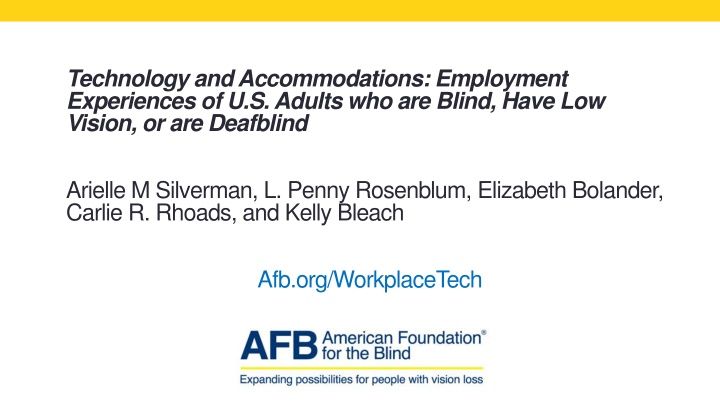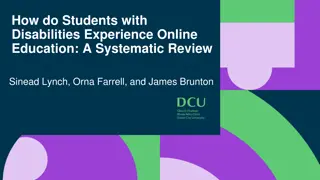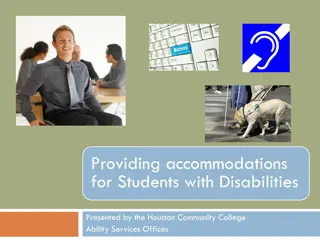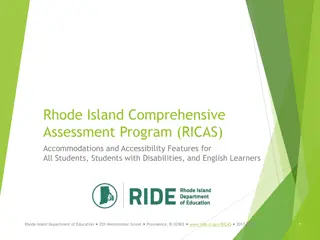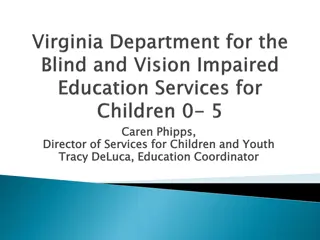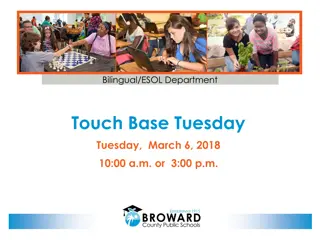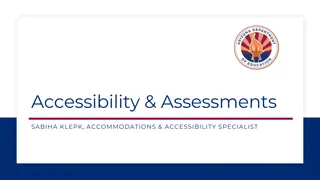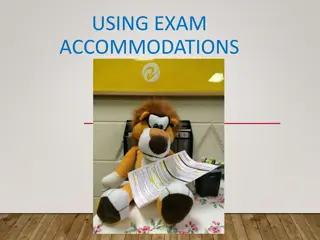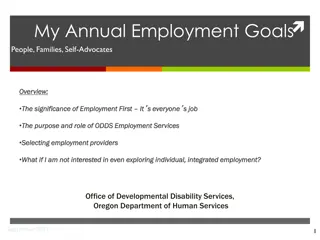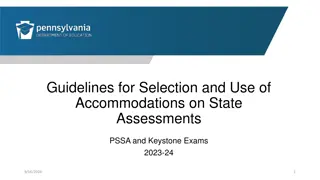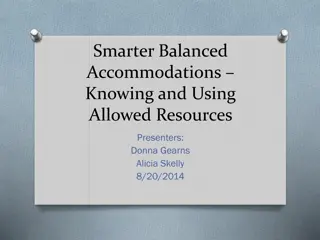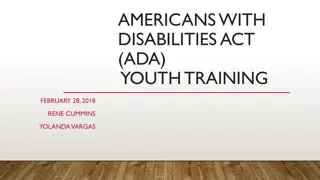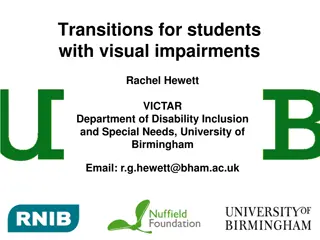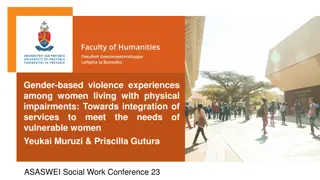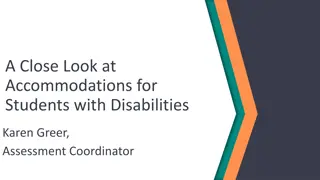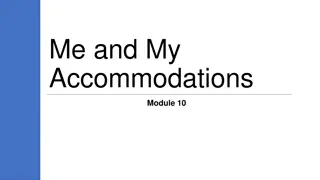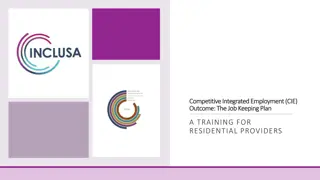Employment Experiences of Adults with Visual Impairments: Technology and Accommodations
This research study explores how technology and accommodations influence the employment experiences of adults in the U.S. who are blind, have low vision, or are deafblind. The study includes literature reviews, focus groups, surveys, and interviews with participants. It provides insights into the demographic information, employment types, job sectors, and assistive technology training received by the participants.
Download Presentation

Please find below an Image/Link to download the presentation.
The content on the website is provided AS IS for your information and personal use only. It may not be sold, licensed, or shared on other websites without obtaining consent from the author.If you encounter any issues during the download, it is possible that the publisher has removed the file from their server.
You are allowed to download the files provided on this website for personal or commercial use, subject to the condition that they are used lawfully. All files are the property of their respective owners.
The content on the website is provided AS IS for your information and personal use only. It may not be sold, licensed, or shared on other websites without obtaining consent from the author.
E N D
Presentation Transcript
Technology and Accommodations: Employment Experiences of U.S. Adults who are Blind, Have Low Vision, or are Deafblind Arielle M Silverman, L. Penny Rosenblum, Elizabeth Bolander, Carlie R. Rhoads, and Kelly Bleach Afb.org/WorkplaceTech
The Importance of Technology In the midst of daily struggles, it's easy to forget how lucky we are to have the technology and opportunity we have today as blind people. I often remind myself to be grateful for that. However, we as blind people have to function in a workplace and compete with sighted peers using tools that are designed specifically for them and not us. This is every tool, every day, all the time, from the coffee maker to the calendar app to the very architecture of the building. White male in his 40s who became visually impaired in childhood 3
The Research Question How does technology and the need for accommodations shape the employment experiences of U.S. adults who are blind, low- vision, or deafblind?
To Answer Our Research Question 1. Literature review 2. Focus groups with 52 participants in Fall 2020 3. Survey in February 2021 Employed participants, n=323 4. Interviews in Summer 2021 25 participants who took part in the survey
Participants Demographic Information Gender: 58% female / 42% male / >.01% nonbinary Race Ethnicity: 80% non-White Hispanic / 20% BIPOC Age: 21-78 years, M = 47 years When Became Visually Impaired: 65% congenital / 18% childhood / 17% adulthood Education: 85% College degree or higher 56% of participants who had a change in vision in the last 5 years requested accommodations
Participants Employment Employment Type Traditional 70% Self-employed 15% Both 6% Job sector: Education and instruction (n=94) Government, community, and human services (n=92) Information technology (n=57) Healthcare (n=36)
Assistive Technology Training Three-fourths of participants received formal tech training: When requesting to learn new technology (n=143) As part of K-12 education (n=137) When a VR staff member recommended the training (n=92) When an employer introduced new technology (n=69) Most participants sought training multiple times in their professional lives.
Other Mainstream Products Nearly all participants used email and Web browsers. Most participants used videoconferencing software. Over half used file sharing, and 40% used instant messaging.
Access Challenges: Onboarding When filling out paperwork in person for my current or most recent job or contract I experienced accessibility challenges due to my visual impairment. (n=293) Disagree or strongly disagree 20% Neither agree nor disagree 22% Agree or strongly agree 58% 0% 10% 20% 30% 40% 50% 60% 70% When filling out paperwork electronically for my current or most recent job or contract I experienced accessibility challenges due to my visual impairment. (n=333) Disagree or strongly disagree 23% Axis Title Neither agree nor disagree 26% Agree or strongly agree 51% 0% 10% 20% 30% 40% 50% 60% Axis Title
Access Challenges: Employer Provided Training 78% of participants had to complete online training 40% of participants reported online training was not accessible. 67% of participants had to complete in-person training. 39% of participants reported in-person training was not accessible. How do employees get the training they need if it is not accessible?
Challenges with Employer Provided Training Lack of description of visual information (e.g., slides) Not receiving material ahead of time for in-person training Lack of alternative text on images or videos Components of online training not accessible (e.g., buttons, login screen, quiz) Having to use sighted assistance and feeling uncomfortable (e.g., subordinate, sensitive information)
Access Challenges: Web Conferencing Screen Reader Users: Content shared from another user s screen is inaccessible Difficulty following chat Difficulty locating files being shared by others Distracting announcements of who enters and exits the room Difficulty muting and unmuting Print Readers: Content shared may be difficult to enlarge or manipulate Difficult to view another window and video conference window simultaneously
Accommodations in the Workplace Coming to a new company as somebody who has accessibility needs is usually a nightmare to navigate processes that are optimized for the 99th percentile and they just don t know how to handle people who have different needs. White male in his 40s who became visually impaired as an adult 3
Accommodations are Not Always Timely With my work computer being a 'managed device' it was very difficult to obtain approvals to get ZoomText installed as it required ADMIN rights and wasn't on their list of approved software. Getting IT to assist and bypass approvals was very difficult at the time. White male who became visually impaired as an adult 3
Telework Participants Teleworking Prior to March 2020 Soon After COVID-19 Began 0% 10% 20% 30% 40% 50% 60% 70% 80% 90% 100% Changes in work responsibilities as a teleworker: Attending meetings online Learning to use a web conferencing tool Changing how one used web conferencing tools Meeting with clients using online meeting tools Presenting to others Working jointly on projects Learning to use instant messaging Learning to file share 39% of teleworkers wanted to continue to telework post- pandemic
Teleworking as a Person who is Visually Impaired I think [the] COVID-19 [pandemic] has demonstrated that we are rethinking the conventional workplace model. Working from home is an attractive choice for all, not just the disabled community. Technology is overcoming the sense of disconnectedness typically associated with working from home. White male in his 40s who became visually impaired in childhood 3
Self-Employment I already have an established online reputation. There are certain types of clients I don't work with, some teaching pedagogies are very visual. I can request things sent ahead of time, it's policy so nobody questions it I feel less anxious when framing it this way: "We'll have a productive hour if I can read materials ahead of time." Asian-American female in her 20s who is self-employed as an online English language teacher 3
Importance of Advocacy Being one's own advocate should be one of the first lessons visually impaired people learn right up there with mobility training. I believe this is a skill that needs to be taken more seriously with the vocational rehabilitation organizations. White female in her 50s who is congenitally visually impaired 3
Recommendations for Educators Prioritize training for students in: Keyboarding and PC skills. Ability to problem-solve and self-teach new technology. Self-advocacy skills and ability to explain their tech to others.
Recommendations for Vocational Professionals Maintain professional development on accommodations and assistive technology needed by those who are blind, have low vision, or are deafblind in the workplace. Connect clients with technology workshops and other AT users. Educate clients about their legal rights and responsibilities. Ensure clients receive AT training if needed.
Recommendations for Employers Develop a centralized, comprehensive accommodations policy. Ensure that employee hiring, onboarding and training procedures are fully accessible. Only procure technology tools that are accessible and usable. Consult with employees who use AT before adopting new technologies.
How It Should Work! My company is massive, and they have onboarded blind people before. Most important though was the culture of enthusiastic continued learning. Everyone just wanted to know more about what they could do, if something didn't work, and how we could fix things together. This allows me to have an open channel of communication with the IT folks, where I document software issues with narrated screen recordings for them, and with HR, for the rare situations when my blindness affects my employment in human-related ways. White female in her 20s who is congenitally visually impaired 3
Final Thoughts Just because you have vision loss doesn't mean you're not capable. It's transforming and educating the employers that visually impaired people are capable. White male in his 70s who became visually impaired as an adult 3
Study Sponsors eSight Google Hadley James H. and Alice Teubert Foundation JPMorgan Chase LCI Foundation Microsoft Vispero Thank you!
